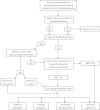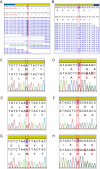Simultaneous sequencing of 24 genes associated with steroid-resistant nephrotic syndrome
- PMID: 23349334
- PMCID: PMC3613958
- DOI: 10.2215/CJN.07200712
Simultaneous sequencing of 24 genes associated with steroid-resistant nephrotic syndrome
Abstract
Background and objectives: Up to 95% of children presenting with steroid-resistant nephrotic syndrome in early life will have a pathogenic single-gene mutation in 1 of 24 genes currently associated with this disease. Others may be affected by polymorphic variants. There is currently no accepted diagnostic algorithm for clinical genetic testing. The hypothesis was that the increasing reliability of next generation sequencing allows comprehensive one-step genetic investigation of this group and similar patient groups.
Design, setting, participants, & measurements: This study used next generation sequencing to screen 446 genes, including the 24 genes known to be associated with hereditary steroid-resistant nephrotic syndrome. The first 36 pediatric patients collected through a national United Kingdom Renal Registry were chosen with comprehensive phenotypic detail. Significant variants detected by next generation sequencing were confirmed by conventional Sanger sequencing.
Results: Analysis revealed known and novel disease-associated variations in expected genes such as NPHS1, NPHS2, and PLCe1 in 19% of patients. Phenotypically unexpected mutations were also detected in COQ2 and COL4A4 in two patients with isolated nephropathy and associated sensorineural deafness, respectively. The presence of an additional heterozygous polymorphism in WT1 in a patient with NPHS1 mutation was associated with earlier-onset disease, supporting modification of phenotype through genetic epistasis.
Conclusions: This study shows that next generation sequencing analysis of pediatric steroid-resistant nephrotic syndrome patients is accurate and revealing. This analysis should be considered part of the routine genetic workup of diseases such as childhood steroid-resistant nephrotic syndrome, where the chance of genetic mutation is high but requires sequencing of multiple genes.
Figures


Similar articles
-
Clinical utility of genetic testing in children and adults with steroid-resistant nephrotic syndrome.Clin J Am Soc Nephrol. 2011 May;6(5):1139-48. doi: 10.2215/CJN.05260610. Epub 2011 Mar 17. Clin J Am Soc Nephrol. 2011. PMID: 21415313 Free PMC article.
-
Clinical genetic testing using a custom-designed steroid-resistant nephrotic syndrome gene panel: analysis and recommendations.J Med Genet. 2017 Dec;54(12):795-804. doi: 10.1136/jmedgenet-2017-104811. Epub 2017 Aug 5. J Med Genet. 2017. PMID: 28780565 Free PMC article.
-
Spectrum of mutations in Chinese children with steroid-resistant nephrotic syndrome.Pediatr Nephrol. 2017 Jul;32(7):1181-1192. doi: 10.1007/s00467-017-3590-y. Epub 2017 Feb 15. Pediatr Nephrol. 2017. PMID: 28204945 Free PMC article.
-
Steroid Resistant Nephrotic Syndrome-Genetic Consideration.Pril (Makedon Akad Nauk Umet Odd Med Nauki). 2015;36(3):5-12. doi: 10.1515/prilozi-2015-0073. Pril (Makedon Akad Nauk Umet Odd Med Nauki). 2015. PMID: 27442391 Review.
-
NPHS2 mutations in steroid-resistant nephrotic syndrome: a mutation update and the associated phenotypic spectrum.Hum Mutat. 2014 Feb;35(2):178-86. doi: 10.1002/humu.22485. Epub 2013 Dec 9. Hum Mutat. 2014. PMID: 24227627 Review.
Cited by
-
Coinheritance of COL4A5 and MYO1E mutations accentuate the severity of kidney disease.Pediatr Nephrol. 2015 Sep;30(9):1459-65. doi: 10.1007/s00467-015-3067-9. Epub 2015 Mar 5. Pediatr Nephrol. 2015. PMID: 25739341 Free PMC article.
-
A steroid-resistant nephrotic syndrome in an infant resulting from a consanguineous marriage with COQ2 and ARSB gene mutations: a case report.BMC Med Genet. 2019 Oct 28;20(1):165. doi: 10.1186/s12881-019-0898-4. BMC Med Genet. 2019. PMID: 31660881 Free PMC article.
-
Cellular Models for Primary CoQ Deficiency Pathogenesis Study.Int J Mol Sci. 2021 Sep 22;22(19):10211. doi: 10.3390/ijms221910211. Int J Mol Sci. 2021. PMID: 34638552 Free PMC article. Review.
-
Defining nephrotic syndrome from an integrative genomics perspective.Pediatr Nephrol. 2015 Jan;30(1):51-63; quiz 59. doi: 10.1007/s00467-014-2857-9. Epub 2014 Jun 3. Pediatr Nephrol. 2015. PMID: 24890338 Free PMC article. Review.
-
Podocyte dedifferentiation: a specialized process for a specialized cell.Front Endocrinol (Lausanne). 2014 Oct 1;5:148. doi: 10.3389/fendo.2014.00148. eCollection 2014. Front Endocrinol (Lausanne). 2014. PMID: 25324828 Free PMC article. Review.
References
-
- Sinha MD, Castledine C, van Schalkwyk D, Hussain F, Lewis M, Inward C: UK Renal Registry 13th Annual Report (December 2010): Chapter 5: Demography of the UK paediatric renal replacement therapy population in 2009. Nephron Clin Pract 119[Suppl 2]: c97–c106, 2011 - PubMed
-
- Rood IM, Deegens JK, Wetzels JF: Genetic causes of focal segmental glomerulosclerosis: Implications for clinical practice. Nephrol Dial Transplant 27: 882–890, 2012 - PubMed
-
- Büscher AK, Kranz B, Büscher R, Hildebrandt F, Dworniczak B, Pennekamp P, Kuwertz-Bröking E, Wingen AM, John U, Kemper M, Monnens L, Hoyer PF, Weber S, Konrad M: Immunosuppression and renal outcome in congenital and pediatric steroid-resistant nephrotic syndrome. Clin J Am Soc Nephrol 5: 2075–2084, 2010 - PMC - PubMed
Publication types
MeSH terms
Supplementary concepts
Grants and funding
LinkOut - more resources
Full Text Sources
Other Literature Sources
Medical

